Searching for Ancestral Memories
Mogilev-Podolsky and Czernowitz
Trip Report
Introduction - Part 1 - Part 2 - Part 3
Part II-Czernowitz
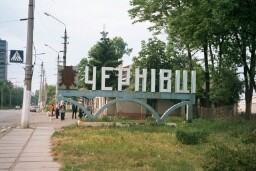
Once we passed the small towns on the way and crossed the River Prut, we knew were entering a city. Albeit a small city, Czernowitz is definitely not a stetl! People walking on the streets are dressed in appropriate city attire, the streets are clean (although full of potholes) and there is an excitement in the air.
We arrived at our hotel--Chermosh--a large Soviet style building--and proceeded to check in. When we asked for directions to the coffee shop, the reception desk clerk motioned us over to speak to a translator who would direct us. The translator introduced herself as Zoya. "Zoya," I cried, "I've been trying desperately to contact you." I showed her my correspondence with Haim Cohen from Israel who recommended her to me. We went to her office and arranged for her to be our guide and Alex to be our driver. This lady is so special. She speaks about six languages fluently, including English. She knows everyone in town and everyone knows her. Although she is Christian she has a wealth of knowledge about the Jewish history of Czernowitz and is familiar with all the Jewish places. We were so lucky to have her as our guide.
We started on a general tour of the city. The center was partially restored in 1980 because the Olympic Torch was passing through Czernowitz from Roumania. Since 1991, when Ukraine became independent, they started painting the buildings in lovely pastel shades reminiscent of bygone days and so different from the Soviet gray. The architecture is exquisite and the buildings are generally in good shape.
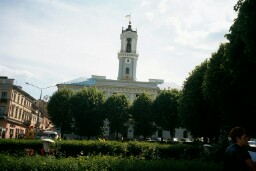 |
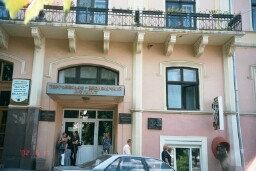 |
Some scenes from the city center of Czernowitz
 |
 |
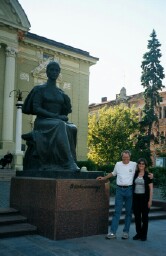 |
 |
The Jewish National House was built in 1908 and the first International Yiddish Conference was held there in that same year. The government used this building in Soviet times, but a part of it has now been returned to the Jewish community. We walked inside and noticed
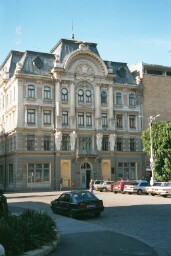 |
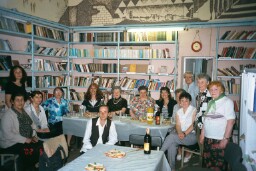 |
that there was a celebration going on. It was Shavuot and the tables were laden with dairy dishes and fruits appropriate for this Jewish festival. Very quickly, we were welcomed and pressed to join in the repast. Everyone was asking questions about my family that once lived in Czernowitz. Language was no problem. Their German was the same as was spoken in my parents' home--not too snooty, with a little Yiddish thrown in. It seemed as though I had been away on a long journey and had just returned home. I quickly developed a rapport with another woman about my age with whom I hope to correspond. As we were preparing to go, Joseph Burg, the Yiddish author, was on the phone and asked to speak to me. He invited us over for a visit to his apartment the next day. Wonderful things just magically happen in this little Camelot.
Next, we went to see the university. The facility built about 1875 is in the former residence of the Bukowina Archbishop. The buildings and grounds are lovely. Our guide told us that when the architect designed the buildings, he wanted to incorporate something Jewish. Pictured below is a close-up of one of the domes. Below the cross are Stars of David encircling the bottom of the dome. This story seems incredible, but I knew that the archbishop of Czernowitz had saved the Torah scrolls from being burned during WWI. He transferred them to his personal residence, kept them there until the end of the war and then returned them to the Jewish community.
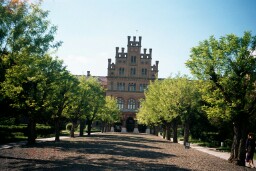 |
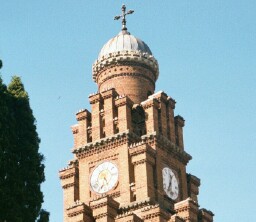 |
I wanted to find the houses of grandparents. From the time that I was a little girl I knew the address. First it was on An der Lene Gasse 5 and 7 and then during Roumanian times it became Strada Pante' 5 and 7. The problem is that it was changed once again after 1945 to a Russian name. Our guide had a book that referenced back to German and Roumanian streets, but we were unable to find this one. One good piece of documentation I brought with me was a 1941 map of Czernowitz which had the street names in Roumanian, and Strada Pante' was on this map. Our driver and guide were determined to find the house for us. Based on this map we went to the location shown as Strada Pante'. In addition to being re-named, the streets have been reconfigured in this area. To the best of our combined abilities we decided that the houses shown below are numbers 5 and 7 Pante'. The address now is on Mozart Street.
 |
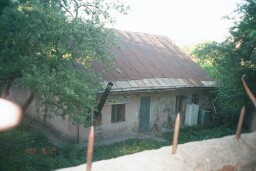 |
Someone lives in No. 5 but was not at home. This was my parents' house. No.
7 was the home of my grandparents and is currently unoccupied. From a conversation
with a neighbor we learned that this house was used as storage for a factory
which is behind the house. I will save this for more research before my next
trip.
 |
 |
The next day, we went to the area that my mother lived in as a child. I knew
the address to be No. 63 in Clocucica. This must be it, the guide told me, because
there is only one street in Clocucica with numbers as high as 63. Later my parents
lived on Neue Welt Gasse.
One of the highlights of this trip was finding my great-grandparents' graves at the Czernowitz cemetery. When we first walked around the cemetery, I realized very quickly that I would not be able to find their graves by myself. Luckily I brought pictures of the gravestones that I found in my grandmother's Siddur. Zoya's friend who works for the city was able to find their location, and we hired someone to actually find the gravestones.
 |
 |
 |
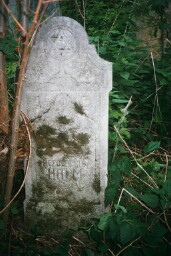 |
 |
 |
|
1946
|
2002
|
The Jewish cemetery in Czernowitz is in fair condition. There is evidence of vandalism in that approximately 10 percent of the stones have some damage. Zoya told us that two years ago there was an incident where some youths knocked down many of the stones in a rampage one night. Apparently this was not an anti-Semitic act since they did the same to the Christian cemetery across the street. The mayor of Czernowitz alerted the President of Ukraine and within hours the local army unit was in the cemetery repairing the damage. However I saw many stones that were still broken.
 |
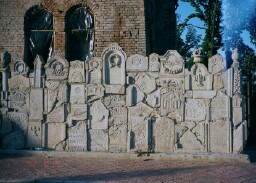 |
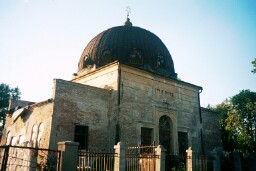 |
Upon first entering the cemetery, there is a prayer house that appears to be
in great disrepair. It was locked so we could not enter it. In front of the
prayer house is a memorial wall constructed of broken tombstones. This is a
recent addition.
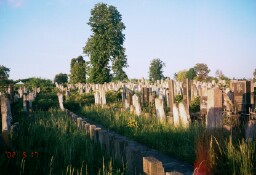 |
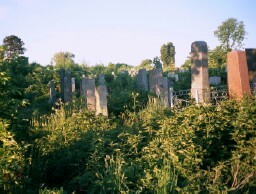 |
The vegetative growth is incredible and the weeds are a constant problem. To access the graves of my great-grandparents we walked through an area that was jungle-like where the growth was in excess of 12 feet high. In the picture on the right is a chestnut tree, a symbol of Ukraine.
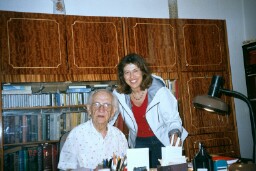
On our second day in Czernowitz, we went to visit the Yiddish writer, Joseph Burg. What a delightful person! We spoke in four languages: English, German, Hebrew and Yiddish--I had a hard time keeping up with him, and he speaks Russian as well. By now he has celebrated his 90th birthday, which was May 31. There was to be a lovely birthday program scheduled, and I wish we could have attended. Unfortunately, he is quite ill and was recently in the hospital. We spoke of many things concerning Czernowitz and his experiences during the war. He told us that there is a Jewish school now in Czernowitz, albeit with many non-Jewish students--but that is good too, he said. He autographed a couple of his recent books for me. We invited him out for lunch with us but he said he wasn't feeling well--next time.
Unfortunately, that afternoon was not a pleasant one for me. Steve wasn't feeling well so we took him back to the hotel. I continued with Zoya and Alex and we drove out to Sadgora. I've seen many pictures of forgotten graveyards in Eastern Europe both in books and on the web. But when I saw this graveyard, I just wanted to cry. How is it possible that we Jews can allow our ancestors' final resting place to be so neglected. Zoya told me that there have been several efforts to preserve the cemetery. At one time some foreign Jews erected a fence, only to be removed for private use by the locals. There is no evidence of a fence now. Many of the stones are broken and toppled. There is a small building on the grounds which is locked. This building houses the graves of the Friedman rabbis.
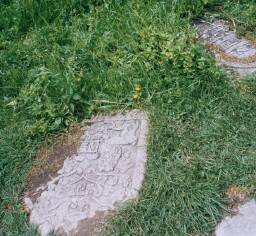 |
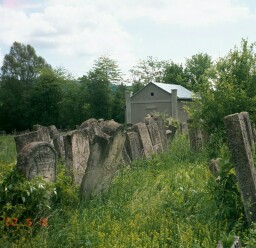 |
 |
The afternoon did not improve as we went to visit the palace and synagogue of
Rabbi Abraham Jacob Friedman, a descendent of the Rushyn Dynasty. Whenever you
see the old postcards from Sadgora there is always a picture of the moorish
style castle. Unfortunately in real life, it looks terrible. During the Soviet
period it was used as a workshop of some sort, and although it has been returned
to the Jewish Community, much work needs to be done to restore it. The interior
pictured below is especially deteriorated.
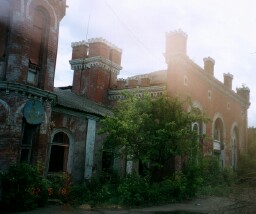 |
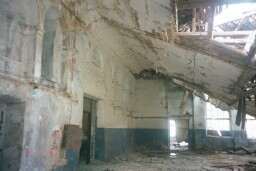 |
 |
 |
The best part of the visit to Sadgora was going to Zoya's house for afternoon tea. She lives in Czernowitz, but has a little house in Sadgora that she inherited from her in-laws. She keeps her cat there and visits every weekend (A neighbor feeds the cat). This house has no indoor plumbing, but is so very clean and the garden is beautiful.
I did not find any evidence in Sadgora of my uncle, Isadore Zimmer, who was killed there along with most of the Jewish population when the Germans first entered. My mother told me that they had heard rumors that the Jews in the villages surrounding Czernowitz were killed. She was so worried about her brother that she paid a Christian woman to go to Sadgora to find out about him. The woman returned and told my mother that he, his wife, and newborn baby were lying dead on the floor of their apartment. They had all been shot. We never had any information on his burial. My poor grandmother was never told about her son's death. When they left for Transnistria she brought his winter coat thinking she would find him there.
To cheer me up, Zoya took me to the Volksgarten in Czernowitz. My parents would go there when they were courting. It so happens that they were celebrating 172 years since the opening of the garden and there was a performance of local talent with Bukowina music and costumes.
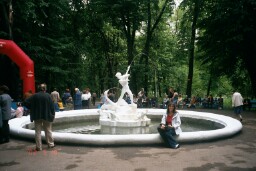 |
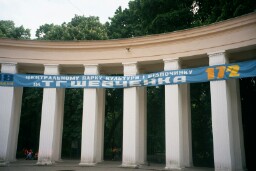 |
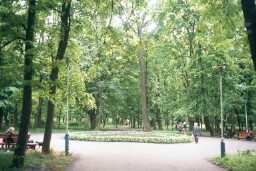 |
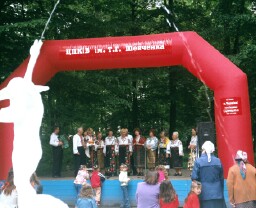 |
![]()
Introduction - Part 1 - Part 2 - Part 3
